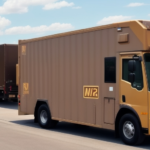Understanding UPS Shipping Rates for the United States
As a business owner or individual who frequently ships packages and parcels, understanding the factors that influence UPS shipping rates is crucial. By comprehending how UPS calculates shipping rates, exploring the different types of UPS shipping services available, and implementing tips for reducing UPS shipping costs, you can save your business money and streamline your shipping processes. This comprehensive guide delves into UPS shipping rates in the United States and addresses common questions about shipping with UPS.
Why Understanding UPS Shipping Rates is Important
Grasping UPS shipping rates is essential for several reasons. For business owners, shipping costs can constitute a significant expense. Knowing how UPS calculates rates empowers you to make informed decisions about which shipping services to utilize, thereby minimizing overall shipping costs. Additionally, UPS shipping rates can fluctuate based on factors such as shipment size, destination, and weight. Understanding these variables helps you anticipate shipping costs and budget effectively.
Moreover, being knowledgeable about UPS shipping rates allows you to provide accurate shipping quotes to your customers. Offering precise estimates fosters trust and prevents disputes over shipping costs. Additionally, understanding UPS shipping rates positions you to negotiate better rates with UPS or other carriers, especially if you have a high volume of shipments. Overall, a solid understanding of UPS shipping rates can significantly benefit your business by saving both time and money.
How UPS Calculates Shipping Rates
UPS determines shipping rates based on several key factors:
- Destination: The geographic location where the package is being sent.
- Package Weight: The total weight of the shipment.
- Package Dimensions: The size of the package, including length, width, and height.
- Shipping Service Selected: The specific UPS service chosen, such as Ground or Express.
Packages are categorized into weight and zone groups, and rates are calculated accordingly. UPS may impose additional fees for packages requiring special handling, such as oversized or hazardous materials. It's important to note that UPS periodically adjusts its rates based on market conditions and other factors.
The delivery time frame also impacts shipping rates. UPS offers various delivery options, including next-day, two-day, and ground shipping. Faster delivery services typically command higher rates, whereas opting for longer delivery times can result in cost savings.
Additionally, UPS provides discounts for customers who ship frequently or in large volumes. These discounts can lead to substantial savings over time. To benefit from these discounts, businesses should consider signing up for a UPS account and enrolling in UPS’s rewards program.
Factors That Affect UPS Shipping Rates
Several factors influence UPS shipping rates:
- Package Size and Weight: Larger and heavier packages generally incur higher shipping costs.
- Destination: Shipping to distant locations typically costs more due to increased transit times and potential customs fees for international shipments.
- Shipping Service: Faster services like UPS Next-Day Air are more expensive than slower options like UPS Ground.
- Item Type: Shipping hazardous materials or fragile items may require additional fees for specialized packaging and handling.
Properly classifying and packaging items is essential to avoid unexpected fees or delays. Ensuring accurate package dimensions and weights can help maintain cost-effectiveness in your shipping operations.
Understanding the Different Types of UPS Shipping Services
UPS offers a variety of shipping services tailored to diverse customer needs:
- UPS Ground: A cost-effective option for domestic shipping within the United States.
- UPS SurePost: Combines UPS efficiency with USPS final delivery, offering lower rates for non-urgent shipments.
- CampusShip: Designed for e-commerce businesses to streamline shipping processes.
- UPS 2nd Day Air: Ensures delivery within two business days across the United States.
- UPS Worldwide Express: Provides expedited international shipping services.
- UPS My Choice: Offers enhanced delivery control, including delivery alerts and the ability to reroute packages.
- UPS In-Store Pickup: Allows customers to collect packages from UPS locations.
Each service comes with its own set of features and benefits, making it important to select the one that best aligns with your business's shipping requirements.
UPS SurePost is particularly beneficial for businesses seeking to reduce shipping costs. By leveraging USPS for final delivery, it offers lower rates compared to standard UPS Ground shipping. However, this service may involve slightly longer delivery times due to USPS handling the final leg of the journey.
UPS My Choice enhances customer experience by providing delivery alerts, flexible delivery scheduling, and the option to reroute packages. This service is invaluable for businesses that need to ensure timely and accurate delivery to their customers.
How to Compare UPS Shipping Rates with Other Carriers
To determine if UPS is the most cost-effective shipping solution for your business, it's essential to compare its rates with other carriers like FedEx, DHL, and USPS. Consider the following when making comparisons:
- Weight and Size: Evaluate how each carrier rates your typical package sizes and weights.
- Destination: Compare domestic and international shipping rates based on your primary shipping locations.
- Shipping Services: Assess the variety and reliability of shipping options each carrier offers.
- Shipping Times: Consider the delivery speed and consistency of each carrier.
- Customer Service: Evaluate the quality of customer support and ease of resolving issues.
- Additional Fees: Be aware of any extra charges, such as fuel surcharges or residential delivery fees.
Another critical aspect is the level of insurance coverage each carrier provides. Some carriers offer higher insurance limits for an additional fee, which can be vital for valuable shipments. Assess your shipping needs and the value of your packages to determine if enhanced insurance coverage is necessary.
For a detailed comparison, consider using online shipping calculators provided by each carrier or consult industry reports from reputable sources like the UPS Research division.
Tips for Reducing UPS Shipping Costs
Implementing strategic measures can significantly reduce your UPS shipping expenses:
- Consolidate Shipments: Combine multiple packages into a single shipment to take advantage of volume discounts.
- Choose Slower Shipping Services: Opt for services like UPS Ground for non-urgent deliveries to save on costs.
- Optimize Packaging: Use appropriately sized and lightweight packaging to minimize shipping costs.
- Utilize UPS Online Tools: Leverage tools such as CampusShip and UPS Internet Shipping to access discounted rates and streamline your shipping process.
- Enroll in UPS Rewards Programs: Participate in programs that offer additional savings and benefits based on your shipping volume.
Additionally, managing your shipments with UPS My Choice can help prevent additional fees related to missed deliveries or incorrect address information. Regularly reviewing and adjusting your shipping practices in line with UPS’s resources can lead to substantial long-term savings.
Understanding Additional Charges and Fees on UPS Invoices
Carefully reviewing UPS invoices is essential to ensure you’re not incurring unnecessary fees. Common additional charges include:
- Oversized Package Fees: Applied to packages that exceed standard size or weight limits.
- Address Correction Fees: Charged when shipment addresses are incorrect or incomplete.
- Fuel Surcharges: Temporary fees that fluctuate based on fuel prices.
Understanding these fees allows you to manage your shipping costs more effectively. For instance, investing in appropriately sized packaging can help you avoid oversized package fees. Ensuring accurate and up-to-date address information can prevent address correction charges.
Stay informed about any updates to UPS’s fee structure by regularly reviewing your invoices and visiting the official UPS Fees and Charges page.
Common Mistakes to Avoid When Using UPS Shipping Services
Avoiding common pitfalls can enhance your shipping efficiency and reduce costs:
- Inaccurate Weight and Size Calculations: Ensure precise measurements to prevent higher shipping costs and unexpected fees.
- Poor Packaging: Use sturdy boxes and appropriate packing materials to protect items and avoid damage during transit.
- Incorrect Labeling: Provide accurate recipient information to prevent delays and additional charges.
- Not Utilizing Volume Discounts: Take advantage of discounts available to high-volume shippers to lower overall costs.
- Ignoring Shipping Deadlines: Adhere to UPS’s shipping deadlines to ensure timely deliveries and maintain customer satisfaction.
Additionally, familiarize yourself with UPS’s shipping policies and deadlines to avoid costly delays and ensure that your shipments meet all necessary requirements.
How to Negotiate Better Rates with UPS for High Volume Shipments
If your business ships a high volume of packages, negotiating better rates with UPS can lead to significant savings. Consider the following strategies:
- Consolidate Shipments: Centralize your shipments to increase volume and qualify for higher discounts.
- Request Volume Discounts: Engage with a UPS representative to explore available discounts based on your shipping volume.
- Optimize Shipping Practices: Adjust package sizes and weights to align with UPS’s most cost-effective rate structures.
- Build a Long-Term Relationship: Developing a strong partnership with UPS can provide access to exclusive discounts and perks.
Engaging in regular reviews of your shipping patterns and costs can also help identify opportunities for further savings. For more detailed information, refer to the UPS Contact page to connect with a representative.
The Impact of COVID-19 on UPS Shipping Rates and Services
The COVID-19 pandemic significantly affected UPS shipping rates and services. The surge in e-commerce and essential goods shipping led to increased demand, prompting UPS to adjust rates and enhance operational capacities. Safety measures, such as contactless deliveries and enhanced sanitation protocols, became standard practices, potentially influencing delivery times and service availability.
Additionally, supply chain disruptions caused by the pandemic affected shipping schedules and costs. UPS responded by expanding its logistics network and introducing new services to accommodate changing customer needs. For the latest updates on how COVID-19 continues to impact UPS services, visit the official UPS COVID-19 Impact page.
Future Trends in Logistics and Their Impact on UPS Shipping Rates
The logistics industry is rapidly evolving, and several emerging trends are poised to influence UPS shipping rates and services:
- Increased Automation: Automation in sorting facilities and the use of robots can enhance efficiency and reduce operational costs, potentially lowering shipping rates.
- Adoption of New Technologies: Innovations such as drones and autonomous vehicles are being explored for last-mile deliveries, which could streamline operations and impact pricing structures.
- Environmental Sustainability: Growing emphasis on sustainability may lead UPS to invest in greener technologies and practices, which could influence shipping rates through eco-friendly service options.
- Global Trade Agreements: Changes in international trade policies and regulations can affect shipping costs and delivery times for global shipments.
Staying informed about these trends allows businesses to anticipate changes in UPS shipping rates and adapt their logistics strategies accordingly. For ongoing insights into logistics trends, refer to industry reports from sources like the UPS Industry Insights.
Conclusion
Understanding UPS shipping rates in the United States is a vital component of effective shipping management. By comprehending how UPS calculates rates, exploring the various UPS shipping services available, and implementing strategies to reduce shipping costs, your business can make informed decisions that lead to significant savings and enhanced operational efficiency. Staying updated with industry trends and regularly reviewing your shipping practices will further ensure that your business remains competitive and cost-effective in its shipping endeavors.




















